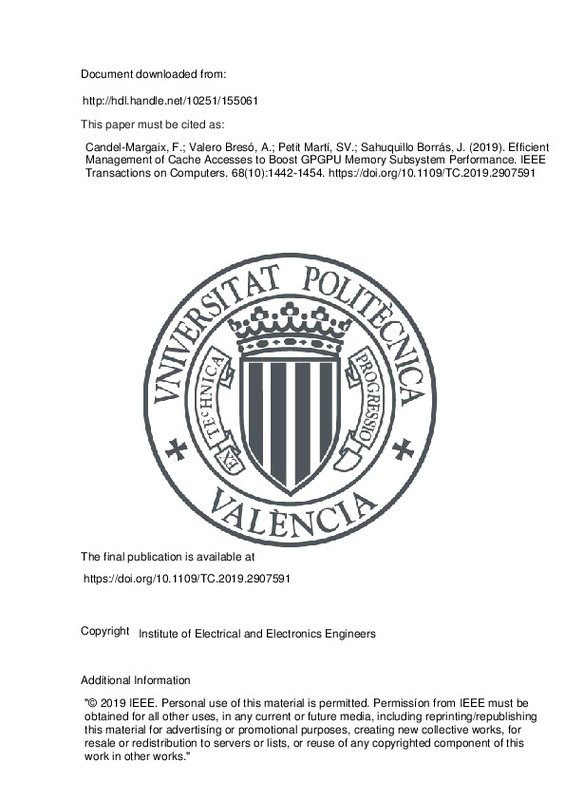|
Resumen:
|
[EN] To support the massive amount of memory accesses that GPGPU applications generate, GPU memory hierarchies are becoming more and more complex, and the Last Level Cache (LLC) size considerably increases each GPU generation. ...[+]
[EN] To support the massive amount of memory accesses that GPGPU applications generate, GPU memory hierarchies are becoming more and more complex, and the Last Level Cache (LLC) size considerably increases each GPU generation. This paper shows that counter-intuitively, enlarging the LLC brings marginal performance gains in most applications. In other words, increasing the LLC size does not scale neither in performance nor energy consumption. We examine how LLC misses are managed in typical GPUs, and we find that in most cases the way LLC misses are managed are precisely the main performance limiter. This paper proposes a novel approach that addresses this shortcoming by leveraging a tiny additional Fetch and Replacement Cache-like structure (FRC) that stores control and coherence information of the incoming blocks until they are fetched from main memory. Then, the fetched blocks are swapped with the victim blocks (i.e., selected to be replaced) in the LLC, and the eviction of such victim blocks is performed from the FRC. This approach improves performance due to three main reasons: i) the lifetime of blocks being replaced is enlarged, ii) the main memory path is unclogged on long bursts of LLC misses, and iii) the average LLC miss latency is reduced. The proposal improves the LLC hit ratio, memory-level parallelism, and reduces the miss latency compared to much larger conventional caches. Moreover, this is achieved with reduced energy consumption and with much less area requirements. Experimental results show that the proposed FRC cache scales in performance with the number of GPU compute units and the LLC size, since, depending on the FRC size, performance improves ranging from 30 to 67 percent for a modern baseline GPU card, and from 32 to 118 percent for a larger GPU. In addition, energy consumption is reduced on average from 49 to 57 percent for the larger GPU. These benefits come with a small area increase (by 7.3 percent) over the LLC baseline.
[-]
|
|
Código del Proyecto:
|
info:eu-repo/grantAgreement/Gobierno de Aragón//T58_17R/
info:eu-repo/grantAgreement/AEI/Plan Estatal de Investigación Científica y Técnica y de Innovación 2017-2020/RTI2018-098156-B-C51/ES/TECNOLOGIAS INNOVADORAS DE PROCESADORES, ACELERADORES Y REDES, PARA CENTROS DE DATOS Y COMPUTACION DE ALTAS PRESTACIONES/
info:eu-repo/grantAgreement/MINECO//TIN2016-76635-C2-1-R/ES/ARQUITECTURA Y PROGRAMACION DE COMPUTADORES ESCALABLES DE ALTO RENDIMIENTO Y BAJO CONSUMO/
info:eu-repo/grantAgreement/UPV//SP20190169/
|
|
Descripción:
|
"© 2019 IEEE. Personal use of this material is permitted. Permissíon from IEEE must be obtained for all other uses, in any current or future media, including reprinting/republishing this material for advertisíng or promotional purposes, creating new collective works, for resale or redistribution to servers or lists, or reuse of any copyrighted component of this work in other works."
|
|
Agradecimientos:
|
This work has been supported by the Spanish Ministerio de Ciencia, Innovacion y Universidades and the European ERDF under Grants T-PARCCA (RTI2018-098156-B-C51), and TIN2016-76635-C2-1-R (AEI/ERDF, EU), by the Universitat ...[+]
This work has been supported by the Spanish Ministerio de Ciencia, Innovacion y Universidades and the European ERDF under Grants T-PARCCA (RTI2018-098156-B-C51), and TIN2016-76635-C2-1-R (AEI/ERDF, EU), by the Universitat Politecnica de Valencia under Grant SP20190169, and by the gaZ: T58_17R research group (Aragon Gov. and European ESF).
[-]
|







![[Cerrado]](/themes/UPV/images/candado.png)


